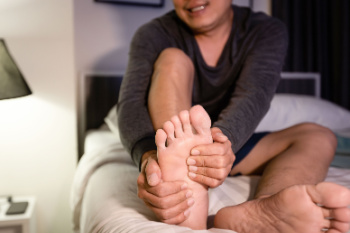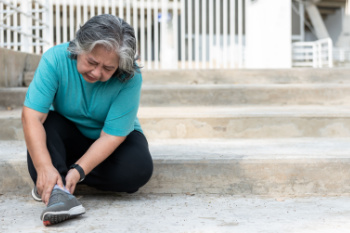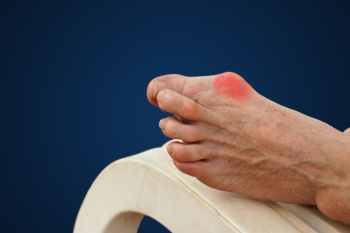
Ingrown toenails occur when the edge of a toenail grows into the surrounding skin, causing pain, swelling, and sometimes infection. This condition most often affects the big toe and can result from improper nail trimming, wearing tight shoes, injury, or a genetic tendency. Early-stage ingrown toenails may respond to warm soaks, gentle lifting of the nail edge, and wearing open or roomier shoes. However, if there is redness, pus, or worsening pain, professional care is necessary. A podiatrist can safely remove the portion of the nail that is causing the problem and may prescribe antibiotics if infection is present. In recurring cases, a simple in-office procedure can prevent the nail from growing inward again. Attempting to treat an ingrown nail at home can increase the risk of complications. For relief and long-term prevention, it is suggested that you see a podiatrist.
Ingrown toenails can become painful if they are not treated properly. For more information about ingrown toenails, contact Gabrielle Clark, DPM of LA Feet Foot & Ankle Center, Inc. Our doctor can provide the care you need to keep you pain-free and on your feet.
Ingrown Toenails
Ingrown toenails occur when a toenail grows sideways into the bed of the nail, causing pain, swelling, and possibly infection.
Causes
- Bacterial infections
- Improper nail cutting such as cutting it too short or not straight across
- Trauma to the toe, such as stubbing, which causes the nail to grow back irregularly
- Ill-fitting shoes that bunch the toes too close together
- Genetic predisposition
Prevention
Because ingrown toenails are not something found outside of shoe-wearing cultures, going barefoot as often as possible will decrease the likeliness of developing ingrown toenails. Wearing proper fitting shoes and using proper cutting techniques will also help decrease your risk of developing ingrown toenails.
Treatment
Ingrown toenails are a very treatable foot condition. In minor cases, soaking the affected area in salt or antibacterial soaps will not only help with the ingrown nail itself, but also help prevent any infections from occurring. In more severe cases, surgery is an option. In either case, speaking to your podiatrist about this condition will help you get a better understanding of specific treatment options that are right for you.
If you have any questions please feel free to contact our offices located in New Orleans, and Metairie, LA . We offer the newest diagnostic and treatment technologies for all your foot and ankle needs.

Plantar fasciitis is a common foot condition involving inflammation of the plantar fascia, a thick band of tissue that connects the heel bone to the toes. This inflammation causes sharp heel pain, often most intense with the first steps in the morning or after long periods of rest. The discomfort may ease with movement, but can return after extended activity. Causes of plantar fasciitis include overuse, poor foot mechanics, or wearing shoes with inadequate support. It is frequently seen in runners, individuals who stand for long hours, or those with flat feet or high arches. Risk factors include age, obesity, and tight calf muscles, which can increase strain on the plantar fascia. Plantar fasciitis can be painful, often causing difficulty in completing daily activities. If you have heel pain, it is suggested that you contact a podiatrist who can provide a diagnosis and treatment.
Plantar fasciitis can be very painful and inconvenient. If you are experiencing heel pain or symptoms of plantar fasciitis, contact Gabrielle Clark, DPM from LA Feet Foot & Ankle Center, Inc. Our doctor can provide the care you need to keep you pain-free and on your feet.
What Is Plantar Fasciitis?
Plantar fasciitis is the inflammation of the thick band of tissue that runs along the bottom of your foot, known as the plantar fascia, and causes mild to severe heel pain.
What Causes Plantar Fasciitis?
- Excessive running
- Non-supportive shoes
- Overpronation
- Repeated stretching and tearing of the plantar fascia
How Can It Be Treated?
- Conservative measures – anti-inflammatories, ice packs, stretching exercises, physical therapy, orthotic devices
- Shockwave therapy – sound waves are sent to the affected area to facilitate healing and are usually used for chronic cases of plantar fasciitis
- Surgery – usually only used as a last resort when all else fails. The plantar fascia can be surgically detached from the heel
While very treatable, plantar fasciitis is definitely not something that should be ignored. Especially in severe cases, speaking to your doctor right away is highly recommended to avoid complications and severe heel pain. Your podiatrist can work with you to provide the appropriate treatment options tailored to your condition.
If you have any questions please feel free to contact our offices located in New Orleans, and Metairie, LA . We offer the newest diagnostic and treatment technologies for all your foot and ankle needs.

People with diabetes are at a higher risk for ankle fractures due to weakened bones and reduced sensation in the feet and ankles. Neuropathy can make it difficult to feel injuries, which may lead to delayed diagnosis and treatment. Poor circulation and slower healing times also increase the risk of complications. Ankle fractures in diabetic patients can be more serious than in the general population. If not treated promptly, they can lead to infections, non-healing fractures, or even Charcot foot, a condition where the bones weaken and collapse. A podiatrist can provide a thorough evaluation and recommend the appropriate treatment, which may include immobilization, surgery, or custom orthotics. If you have diabetes and experience ankle pain, swelling, or difficulty walking, it is suggested you schedule an appointment with a podiatrist who can provide a thorough evaluation and recommend the appropriate treatment, which may include immobilization, surgery, or custom orthotics.
Diabetic foot care is important in preventing foot ailments such as ulcers. If you are suffering from diabetes or have any other concerns about your feet, contact Gabrielle Clark, DPM from LA Feet Foot & Ankle Center, Inc. Our doctor can provide the care you need to keep you pain-free and on your feet.
Diabetic Foot Care
Diabetes affects millions of people every year. The condition can damage blood vessels in many parts of the body, especially the feet. Because of this, taking care of your feet is essential if you have diabetes, and having a podiatrist help monitor your foot health is highly recommended.
The Importance of Caring for Your Feet
- Routinely inspect your feet for bruises or sores.
- Wear socks that fit your feet comfortably.
- Wear comfortable shoes that provide adequate support.
Patients with diabetes should have their doctor monitor their blood levels, as blood sugar levels play such a huge role in diabetic care. Monitoring these levels on a regular basis is highly advised.
It is always best to inform your healthcare professional of any concerns you may have regarding your feet, especially for diabetic patients. Early treatment and routine foot examinations are keys to maintaining proper health, especially because severe complications can arise if proper treatment is not applied.
If you have any questions please feel free to contact our offices located in New Orleans, and Metairie, LA . We offer the newest diagnostic and treatment technologies for all your foot and ankle needs.

A bunion is more than just a bump on the side of your foot. It is a misalignment of the big toe joint that causes the bone to shift outward. This can lead to pain, swelling, and difficulty in finding comfortable shoes. Over time, as the big toe leans further toward the lesser toes, bunions can worsen, and additional foot problems like hammertoes or calluses can arise. Conservative treatments can help manage symptoms. Wearing supportive shoes with a wide toe box, using orthotics, and employing techniques to reduce inflammation are common strategies. For persistent pain or significant deformity, minimally invasive bunion surgery may be recommended to correct the alignment and relieve discomfort. Ignoring a bunion will not make it go away, and early intervention can prevent the condition from getting worse. If you have a painful bunion, it is suggested that you schedule an appointment with a podiatrist to discuss the best treatment options for it, as well as overall foot health.
If you are suffering from bunion pain, contact Gabrielle Clark, DPM of LA Feet Foot & Ankle Center, Inc. Our doctor can provide the care you need to keep you pain-free and on your feet.
What Is a Bunion?
Bunions are painful bony bumps that usually develop on the inside of the foot at the joint of the big toe. As the deformity increases over time, it may become painful to walk and wear shoes. Women are more likely to exacerbate existing bunions since they often wear tight, narrow shoes that shift their toes together. Bunion pain can be relieved by wearing wider shoes with enough room for the toes.
Causes
- Genetics – some people inherit feet that are more prone to bunion development
- Inflammatory Conditions - rheumatoid arthritis and polio may cause bunion development
Symptoms
- Redness and inflammation
- Pain and tenderness
- Callus or corns on the bump
- Restricted motion in the big toe
In order to diagnose your bunion, your podiatrist may ask about your medical history, symptoms, and general health. Your doctor might also order an x-ray to take a closer look at your feet. Nonsurgical treatment options include orthotics, padding, icing, changes in footwear, and medication. If nonsurgical treatments don’t alleviate your bunion pain, surgery may be necessary.
If you have any questions, please feel free to contact our offices located in New Orleans, and Metairie, LA . We offer the newest diagnostic and treatment technologies for all your foot care needs.
